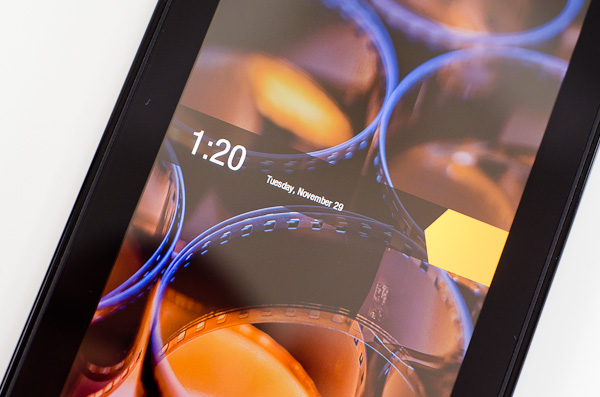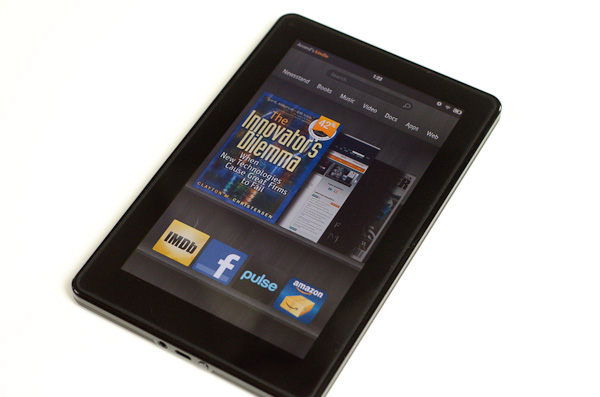Amazon Kindle Fire Review
by Anand Lal Shimpi & Vivek Gowri on November 29, 2011 3:31 AM EST- Posted in
- Tablets
- Mobile
- Amazon
- Kindle Fire
- Kindle
Final Words
The Kindle Fire is probably the best tablet you can buy at $199. Amazon has effectively defined the new price point and specs for entry level tablets, anything comparable shouldn't even bother with a price tag greater than $199. I'm sure this won't come as welcome news to players in the Android space looking to enjoy Apple-like profit margins, but sometimes the truth is hard to hear.
At $199, Amazon is giving you some of the fastest mobile hardware money can buy today. The reason the Kindle Fire isn't a must buy for everyone is because the software experience layered on top of the hardware isn't yet perfect. The OS is clean and easy to navigate but the UI isn't always smooth, interactions aren't always responsive and the browser isn't as pleasant as what you can get from iOS or newer versions of Android.
The counterpoint is that for $499 you can get this software experience, while at $199 you obviously have to give something up. I'd argue that you shouldn't have to give anything up. Much of the software experience I'm asking for is already baked into current or close-to-shipping versions of Android today. Amazon picked an earlier point in the curve to fork from Android, but what I'm asking for is technically possible today. Amazon did the right thing by including the best hardware possible in the Kindle Fire, it simply needs to follow through on the software side to truly unlock it.
Amazon does deserve points for a job well done in a number of areas. First and foremost, the Kindle Fire's version of Android is really well executed. While there are some navigational hiccups, the experience overall is quite good. I would strongly encourage major players in the Android space to look at what Amazon has done when they are considering their own customizations to Google's OS. Yes, sometimes less is actually more.
As much as I'm not a fan of the Silk browser today, I can see where things could go. I do believe that Amazon really wants to deliver the full tablet experience in a device the size of a regular Kindle. Moore's Law will eventually give us that reality, but Amazon may be able to speed things up by moving much of the heavy lifting into the cloud. I do hope this is the future Amazon is working towards and Silk's cloud-side caching isn't solely a power grab for behavioral data.
The integration of Amazon Prime video streaming and the Amazon stores is extremely well done. If you're an Amazon addict, the Kindle Fire will likely do horrible things to your bank account.
I feel like Amazon believes in the Kindle Fire and thus we will see the software get better over time. As with most tablet recommendations lately, if you can wait, doing so would be wise. Don't assume that things will get better, wait for Amazon to make them better and then reward the company with your hard earned dollars.
That being said, more concrete recommendations are always nice so here we go:
1) If all you do is read eBooks, grab a regular Kindle. The reading experience is far better on those devices. Sure response time is noticeably longer than on the Kindle Fire, but you do get better battery life, a display that's easier on your eyes, etc...
2) If you already have an iPad/Honeycomb tablet, look elsewhere. I appreciate you reading this review but don't buy a Kindle Fire. If you really want something more portable to read books on, see point 1.
3) If you need an entry level tablet, the Kindle Fire is as good as they get for $199. You get the same general purpose compute and memory as an iPad 2, at a far lower price. GPU performance isn't a knockout but as long as you're not a hardcore 3D gamer (do those exist on Android yet?) or high end game developer this isn't an issue.
I'm curious to see how this plays out. The e-ink Kindle has a unique (perfect?) form factor and delivers a pretty good experience. The Kindle Fire has a more generic form factor (perhaps too small for certain uses?) and delivers a varied experience depending on what you're doing. I appreciate what Amazon is trying to do here: good tablet experiences shouldn't cost as much as much higher performing computing devices, and cheap tablets shouldn't sacrifice everything to get there. The Kindle Fire is Amazon's first attempt at bridging the gap between those two extremes. It's the best out today given its price point, but it's not the best Amazon could have done. I'm waiting for round two.












70 Comments
View All Comments
Reflex - Tuesday, November 29, 2011 - link
No, part of the reason Amazon forked Android was to eliminate Google services and analytics. No Google account required, nothing is shared with Google unless you choose to install their apps and services. Amazon also has very strict privacy policies and does not share user information with anyone(even internally from what I understand).stationstops - Tuesday, November 29, 2011 - link
As a commuter, I am on my iPad2 3 hours a day. I would love to try the Kindle Fire as a less cumbersome replacement (for me, it either fits in the pocket of the sport coat or it doesn't), but without 3G, there is absolutely no productivity for me here at all.Its kind of amazing how little importance 3G is given in the press when discussing Android tablets. They commonly get released with no 3G version at all, and when the 3G versions do come out, they have contracts and pricing which simply can't compete with iPad's liberal Verizon and AT&T month-to-month plans.
Keep in mind that this great 2011 tablet computer has worse connectivity then a Gen 1 Kindle.
melgross - Tuesday, November 29, 2011 - link
It's interesting that most reviews from Anand pick apart even the smallest problems, but this review seems to gloss over them. Is it really possible that Anand and Vivek didn't have the problems that other reviewers had?Problems mentioned in other reviews include, turning off the tablet when watching movies, browsing, or doing any activity because of the poor placement and implementation of the
Owner button.
The need to often tap several times to get the screen to respond, or to find that the tablet did, after a lag, detect a tap, but now moves you to something else because you tapped too often.
The lack not only of a microphone, but a rear and front camera, so no Skype possible.
Also no gyro. Amazon doesn't allow apps in their store if it uses any of these features.
Many side loaded apps either don't work, or have problems if they do. And sideloading apps isn't for the average user anyway, so most are stuck with what Amazon approves, which isn't much.
Many tap points are small (and as mentioned, not always responsive), and so people with vision problems or motor control problems will have difficulty with this.
Overall, this isn't such a great product. I'm surprised that Anand didn't go more deeply into this. There's no excuse that it's just $200. For that we should get something that lacks features, but it should still work well for what it does.
Wizzdo - Tuesday, November 29, 2011 - link
I agree. I feel this review isn't up to the usual high standards. The points melgross states are quite salient. Anand mentions that the Kindle Fire is no iPad 2 but this is for many more reasons than size and graphics horsepower alone.cat12 - Tuesday, November 29, 2011 - link
I have own a older molder kindle (purchased 6 months ago) I was very pleased with it and still am. Well I had to try the fire. I did not like the back light at all. When you work on computers all day you eyes fatigue. With the older kindle seems like you are reading a book and is much easier on the eyes.As far as the internet web browsing it was redundant since I have laptop etc... The film quaility of the movies on the fire was excellent but again redundant.
Also I could view my external mail account but could not open the messages, so it was useless as a business tool. The fire seems to be much heavier, and do not think for a moment that you can use your old protective cover for the fire. You will have to lay out cash for a new one to fit the fire.
I returned the fire after a couple of days and am awaiting my refund from amazon. I will continue to enjoy my older kindle for the "book" reading experience, after all that is why I wanted a kindle in the first place.
NCM - Tuesday, November 29, 2011 - link
"Amazon refused to skimp in two areas: compute and the display.""this is more general purpose compute..."
Please: "compute" is a verb, not a noun.
bludragon - Tuesday, November 29, 2011 - link
This is my single biggest gripe with the browser, especially in landscape, most of the screen is wasted on the buttons and status bar. Unless I'm being really dumb and missed the option to get rid?Aside from Netflix, nothing I searched for in the app store was there. I don't think I'm asking a lot...
1. Zinio
2. Google maps
3. Yelp
4. Firefox, opera or some other web browser to get around the browser irks and the few buggy web sites (typically where pop up ads prevent you from seeing the page, or you can't select things on pop up menus)
Bazili - Tuesday, November 29, 2011 - link
It's time to create a device with both displays and a simple smart cover that shifts the device from one mode to another.Isn't it possible, is it?
VivekGowri - Wednesday, November 30, 2011 - link
The NotionInk Adam is a similar idea to what you're talking about.geniekid - Tuesday, November 29, 2011 - link
A lot of people say they don't understand the comparison between the Fire and an iPad, but I think there's value to such a comparison.Yes, I KNOW the iPad is obviously a superior piece of hardware to the Fire and it was designed to meet different needs. I need to know EXACTLY what those different needs are. What does that extra $400 dollars buy me? I would guess at least half the people reading reviews about the Fire want to know how it compares to the iPad, EVEN IF THEY ALREADY UNDERSTAND that the two are targeting different demographics.